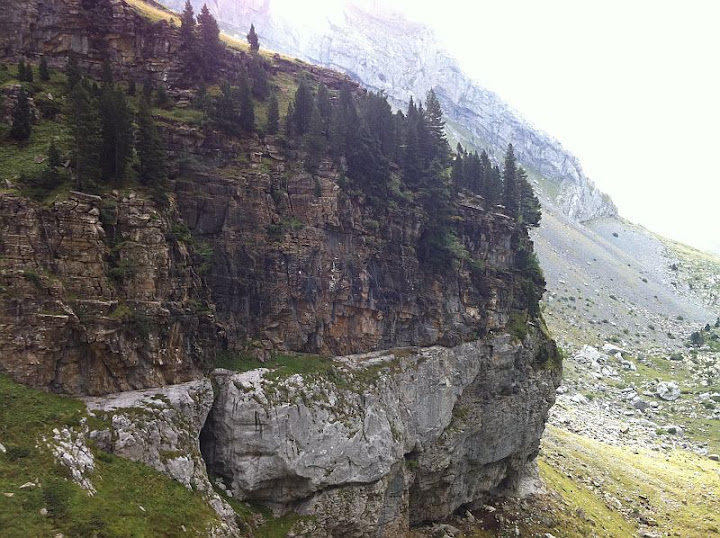Geologists apply the terms allochthonous and autochthonous to various different phenomena which have common characteristics. “Allochthonous” refers to something that has formed elsewhere. This “something” can be a huge mountain block that has been pushed tectonically atop of another block. Or it can refer to mineral grains or rock fragments that were previously parts of another rock which have since decayed and liberated the fragmants. These grains were then picked up by running water, carried to another place, and deposited as an allochthonous (or allogenic) sediment.

This is a thrust fault from the Spanish Pyrenees. Siltstone formation (upper dark layer) is pushed on top of gray limestone formation which is actually younger and should be on top of siltstone in a normal succession. Siltstone is clearly allochthonous because it is removed from its original position.
Conversely, sediments that formed in place are called autochthonous or authigenic. It does not mean that the material these sediments or rocks are made of can not be from an external source (it usually is) but the resulting rock or its particles did not exist in this form as part of a pre-existing rocks. For example, quartz grains in sandstone were already in existence inside granite before this rock weathered and liberated these grains which were then transported to another place and deposited as sand. These quartz grains are allochthonous. However, sodium ions that were part of the same granite were liberated as well but they combined with chlorine ions to become rock salt. This is entirely different material that was not present in granite. Hence, rock salt is said to be an autochthonous chemical sediment.

conglomerate is a sedimentary rock which is composed of allochthonous material. Width of sample from Norway is 9 cm.
The bulk of sediments are allochthonous. They are usually referred to as detrital or clastic sediments. Common allochthonous sediments are sand, silt, clay, and gravel. On the other hand, the vast majority of the Earth’s upper crust is autochthonous because the upper part of the crust tends to be relatively young and is usually composed of sedimentary rocks which generally have not moved since they were deposited. Things are different deeper in the crust. Metamorphic rocks beneath the thin veneer of sedimentary rocks are usually formed as a result of regional metamorphism which may include several mountain building episodes which tend to move large blocks of the crust out of its original position. However, these rocks are usually so old, often poorly exposed, and may have suffered multiple episodes of metamorphic overprinting which makes it very difficult to understand the bigger picture. It is a better idea to go and see some younger mountain range up-close if you want to see allochthonous parts of the crust.

Gypsum is an authigenic sedimentary rock. It is an evaporite that precipitated out of saline water. Outcrop is located in Cyprus.
Are “autochthonous” and “authigenic” (or “allochthonous” and “allogenic”) entirely synonymous? Actually not. There is a slight difference. Authigenic refers to constituents (sand grains and other sediments) rather than whole formations. Therefore, it is more correct to talk about allochthonous crustal blocks and authigenic sediments1. However, in real life most people are not so pedantic (or correct) and seem to use especially the term “allochthonous” in both situations.
References
1. Jackson, J. A. (1997). Glossary of Geology, 4th Edition. American Geological Institute.